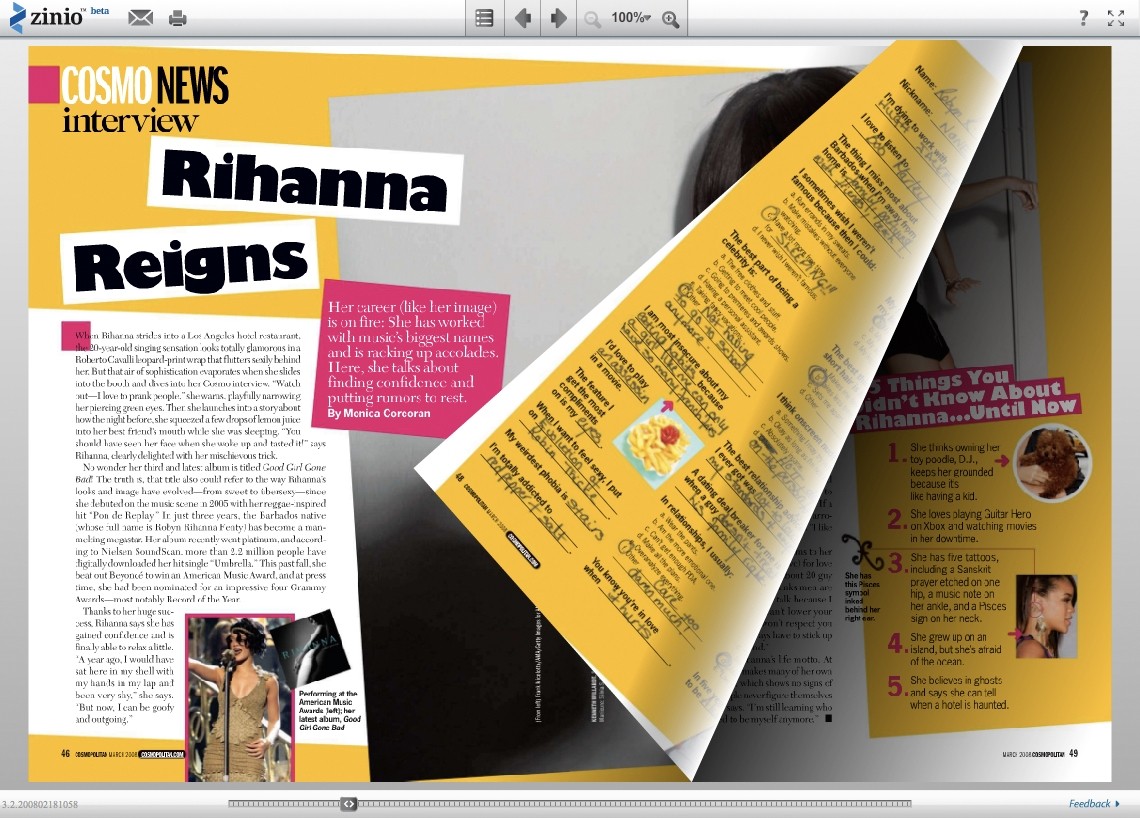Forget the paperless office dream, but how about a paperless living room?


I recently spoke with Rich Maggiotto, CEO of Zinio, based in Silicon Valley. Zinio began as software and a delivery system for digital publication of print titles in the tech sector. Now they deliver a thousand titles from 350 publishers around the world. Their roster includes "Computer Shopper" and "SmartPhone." "Home Theatre" and "Digital Camera World." From Australian pubs to Venezuelan periodicals. From "Beer Magazine" to "Playboy" and "Penthouse." That brings us to the one international barrier Zinio's encountered. Maggiotto said there are some Middle Eastern countries and China blocking some of the title Zinio provides, mostly to prevent access to sexually explicit material. So far there's been little attempt to block political magazines. Sex is more dangerous to some regimes than political debate?
DIGITAL=GREEN, PAPER=RESOURCE SUMP
So what's cleantech about digital publication? Maggiotto helped me count the ways: no need to deliver thousands of paper copies. Big energy savings right there. In the U.S. alone the printed magazine industry eats through 35-million trees annually. Sure, that's renewable, at a cost. No need for ink and glue and....
Magazines on slick paper are not usually recycled, helping produce nearly five billion pounds of solid waste annually. The landfill space is NOT renewable and then there's all that energy consumed just hauling the mags to the store or post office, delivering them, collecting them and then hauling off to the dump.
The magazine industry accounts for thirteen billion pounds of greenhouse gas emissions per year, just in the U.S. And the CO2 production is equal to over a million autos, the daily commute load in a typical burgeoning Sunbelt metro area. But here's the worst part of the whole wasteful and now-unecessary print magazine thing: 70% of all magazines that go to stores are never sold and thus go straight to landfill. Only about 10% of all home-delivered magazines are kept for a year or longer. We know what happens to the rest, not to mention their poly bags and all those pesky insert cards. Stop the pain, already.
ZINIO'S PROMISE
Not only does Zinio short-circuit the whole print and paper miasma, it offers the staid world of print a trio of huge leaps into the 21st Century. First, the digital subscription service allows anybody on the planet to subscribe to any magazine (governments willing) that's on Zinio. A businessman in India or Peru can get instant access to any business magazine as soon as it goes to press, not two weeks later when it arrives by snail mail. A journalist in Malaysia can see European and American news magaziners the minute they are released, not after they've become stale.
A number of magazines have joined the Zinio service only to find their subscriber base goes global. Maggiotto cited one American men's magazine that's very focused on issues and locations in North America. Yet Zinio brought them thousands of new subscribers from countries where the magazine had no marketing and no newsstand presence.
Secondly, Zinio allows traditional print ads to link to video, audio or quicktime animation. Zinio can take the reader directly to an advertiser's page without leaving the magazine. Zinio always tries to use the most widespread software, like Mpeg or Flash, but the service will prompt you to download if you don't have the program. In dollar terms this means magazines can now sell online animation and audio to advertisers. More global subscriber base plus publishers get to up-sell.
Also, Zinio provides 24/7, online access to back issues. It's an archive as well as an agent for the magazine publishers.
Zinio itself already licenses their technology to websites like Barnes & Noble and the McGrawHill textbook store where they sell digital textbooks. Maggiotto says MGH is seeing digital sales double every semester. Further Zinio has stats on readership habits: what articles they read, how long they spend, what ads they follow, etc. In the digital world, advertisers could find out how their ad is being accepted, viewed, etc. Maggiotto says they will track this data without any loss of privacy for the reader/subscriber.
So are we done with poly-bagged magazines and stuffed mail trucks? Meanwhile one magazine has tracked down its own carbon footprint. Here's that blog.
I forgot to ask if Zinio can just deal with all those paper catalogs that fill my recycle bin each week.